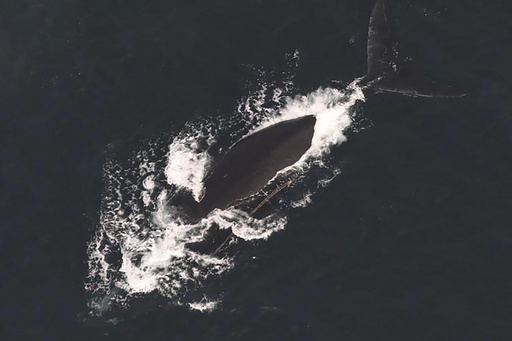
A troubling situation has emerged for the endangered North Atlantic right whale population, with the recent sighting of a third whale caught in fishing gear along the East Coast. This incident raises serious concerns for a species that currently has fewer than 400 individuals remaining, as they face threats from ship strikes and entanglements in fishing equipment.
On December 16, an aerial survey conducted by the National Oceanic and Atmospheric Administration (NOAA) identified an entangled whale approximately 60 miles (96 kilometers) east of North Carolina’s Outer Banks. Just a few days prior, a different survey revealed two more entangled right whales near Nantucket, Massachusetts. According to NOAA officials, similar to one of the whales seen near Nantucket, the whale off the coast of North Carolina is severely injured and is at high risk of mortality due to the entanglement.
NOAA has reported that response teams focusing on entanglements are on standby; however, adverse weather conditions in the affected area currently hinder immediate action. The agency stated that they are committed to collaborating with qualified responders and experts to keep track of the whale when conditions improve.
The entangled whale spotted off North Carolina, identified by the Clearwater Marine Aquarium Research Institute, is a juvenile male born in 2021. NOAA reported that multiple lines of fishing gear are wrapped around and crossing over the whale’s head and mouth.
As noted by Melanie White, the Conservation Project Manager for North Atlantic Right Whales and a research biologist at the Clearwater Marine Aquarium Research Institute, the North Carolina whale has not yet been observed again since its last sighting.
The migratory patterns of right whales take them along the East Coast, where they typically give birth around Florida and Georgia and feed in the waters of New England and Canada. However, the warming of ocean waters has impacted the availability of their food sources, leading the whales to venture outside of their protected marine habitats, making their journey even more dangerous, according to scientific assessments.
From 2010 to 2020, the right whale population saw a staggering decline of about 25%. Although there has been a slight increase in numbers since then, conservationists argue that additional protective measures are crucial for preventing extinction.
Historically, right whales were abundant along the East Coast, but their populations suffered devastating losses during the commercial whaling period. They have been designated as a protected species for numerous years, yet continued efforts are necessary to ensure their survival.

